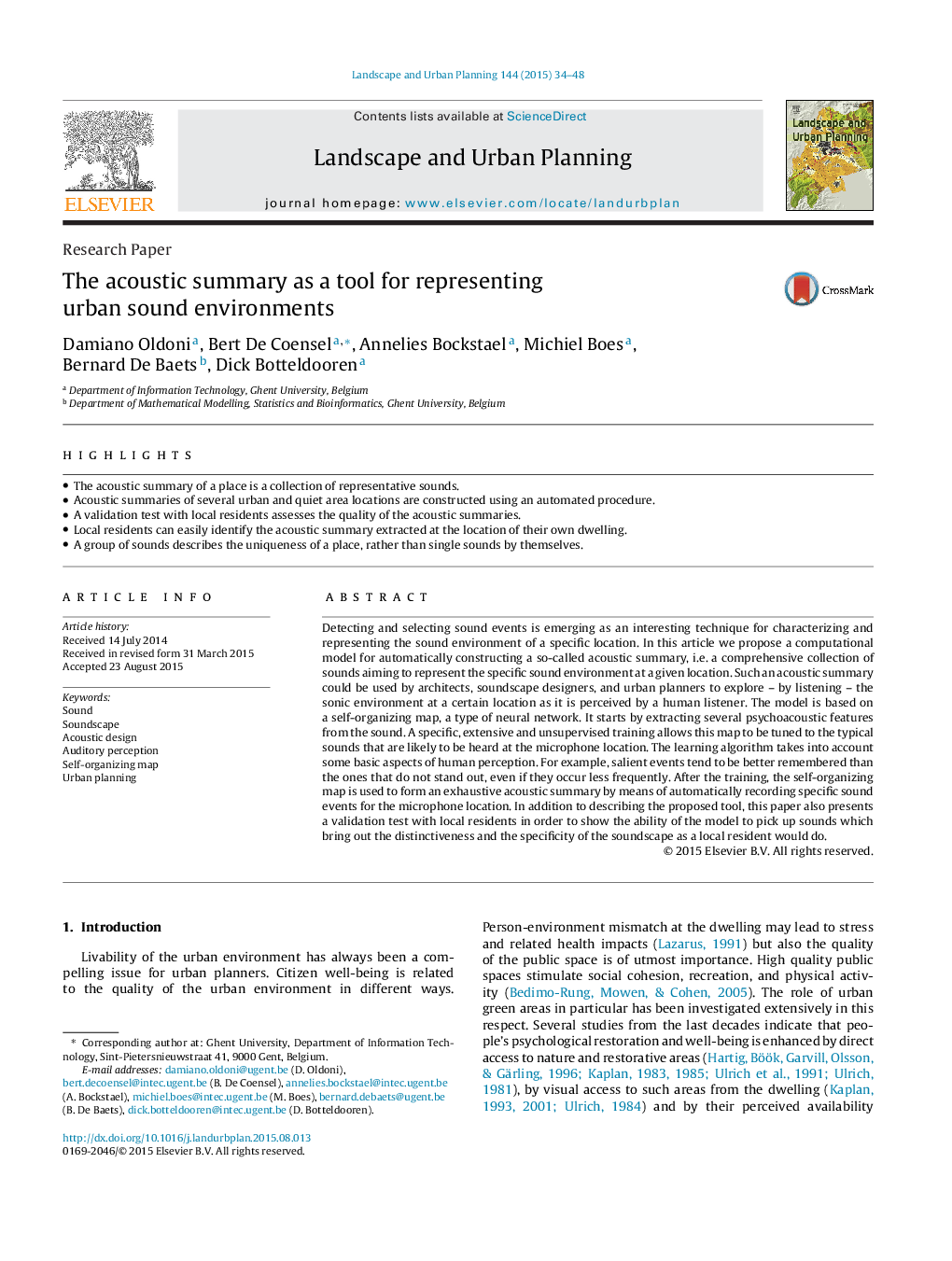| کد مقاله | کد نشریه | سال انتشار | مقاله انگلیسی | نسخه تمام متن |
|---|---|---|---|---|
| 7460884 | 1484614 | 2015 | 15 صفحه PDF | دانلود رایگان |
عنوان انگلیسی مقاله ISI
The acoustic summary as a tool for representing urban sound environments
ترجمه فارسی عنوان
خلاصه آکوستیک به عنوان یک ابزار برای نشان دادن محیط های شهری
دانلود مقاله + سفارش ترجمه
دانلود مقاله ISI انگلیسی
رایگان برای ایرانیان
کلمات کلیدی
صدا، صدای شگفت انگیز طراحی آکوستیک، ادراک شنوایی، نقشه خودمراقبتی، برنامه ریزی شهری،
ترجمه چکیده
تشخیص و انتخاب حوادث صدا به عنوان یک روش جالب برای توصیف و نمایندگی محیط صدا از یک مکان خاص در حال ظهور است. در این مقاله ما یک مدل محاسباتی برای ایجاد یک خلاصه صوتی به اصطلاح، یعنی یک مجموعه جامع از صداها برای نشان دادن محیط صدای خاص در یک مکان مشخص، پیشنهاد می کنیم. چنین خلاصه ای از آکوستیک می تواند توسط معماران، طراحان صوتی و برنامه ریزان شهری مورد استفاده قرار گیرد تا با گوش دادن به محیط صوتی در مکان خاصی به عنوان یک شنونده انسان درک شود. این مدل بر اساس یک نقشه خود سازنده، یک نوع شبکه عصبی است. آن را با استخراج چندین ویژگی شنوایی از صدا آغاز می کند. یک تمرین خاص، گسترده و بدون نظارت اجازه می دهد تا این نقشه را به صداهای معمولی که احتمالا در محل میکروفن شنیده می شود تنظیم شوند. الگوریتم یادگیری به برخی از جنبه های اساسی درک انسانی توجه دارد. به عنوان مثال، حوادث برجسته معمولا بهتر از آنهایی است که برجسته نمی شوند، به یاد می آورند، حتی اگر آنها کمتر اتفاق می افتد. پس از تمرین، نقشه خودسازمانده برای ایجاد یک خلاصه صوتی جامع با استفاده از خودکار ضبط وقایع خاص صدا برای محل میکروفون استفاده می شود. علاوه بر توصیف ابزار پیشنهادی، این مقاله همچنین یک تست اعتبار سنجی با ساکنین محلی ارائه می دهد تا توانایی مدل را برای انتخاب صداها که ویژگی های مشخصی را مشخص می کنند و مشخصه صدای فراگیر به عنوان یک ساکن محلی انجام دهد نشان می دهد.
موضوعات مرتبط
علوم زیستی و بیوفناوری
علوم کشاورزی و بیولوژیک
بوم شناسی، تکامل، رفتار و سامانه شناسی
چکیده انگلیسی
Detecting and selecting sound events is emerging as an interesting technique for characterizing and representing the sound environment of a specific location. In this article we propose a computational model for automatically constructing a so-called acoustic summary, i.e. a comprehensive collection of sounds aiming to represent the specific sound environment at a given location. Such an acoustic summary could be used by architects, soundscape designers, and urban planners to explore - by listening - the sonic environment at a certain location as it is perceived by a human listener. The model is based on a self-organizing map, a type of neural network. It starts by extracting several psychoacoustic features from the sound. A specific, extensive and unsupervised training allows this map to be tuned to the typical sounds that are likely to be heard at the microphone location. The learning algorithm takes into account some basic aspects of human perception. For example, salient events tend to be better remembered than the ones that do not stand out, even if they occur less frequently. After the training, the self-organizing map is used to form an exhaustive acoustic summary by means of automatically recording specific sound events for the microphone location. In addition to describing the proposed tool, this paper also presents a validation test with local residents in order to show the ability of the model to pick up sounds which bring out the distinctiveness and the specificity of the soundscape as a local resident would do.
ناشر
Database: Elsevier - ScienceDirect (ساینس دایرکت)
Journal: Landscape and Urban Planning - Volume 144, December 2015, Pages 34-48
Journal: Landscape and Urban Planning - Volume 144, December 2015, Pages 34-48
نویسندگان
Damiano Oldoni, Bert De Coensel, Annelies Bockstael, Michiel Boes, Bernard De Baets, Dick Botteldooren,
